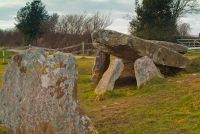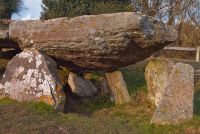
A further nine stones make up the entrance passage almost a metre wide. Interestingly, the passage starts off almost due east to west before taking a sharp dogleg to the south.
Near the chamber are a further two standing stones, which may originally have been part of a trilithon. If so, the lintel stone is no longer in place.
All of the stones were originally covered by a broad oval mound, measuring roughly 22 metres by 19 metres. Several kerbstones lie at the outer extremity of the mound.
A Neolithic settlement on nearby Dorstone Hill may be associated with Arthur's Stone. The association of this ancient site with King Arthur appears to date from at least the 13th century, if not earlier.
Local legends say that Arthur killed a giant on this spot, and when the giant fell, his elbows made an impression in one of the stones. Similar stories associating King Arthur with prehistoric sites are told throughout Herefordshire and the Welsh borderland.
Arthur's Stone was the subject of a segment on the popular televsion archaeology programme Digging for Britain, with host Dr Alice Roberts. The programme looked at investigations by a team of archaeologists who revealed the site's complex history, including the fact that it was developed over a long period of time.
The original dolmen was approached by a ceremonial, or processional way, and the entire site was later covered by a large burial mound with a forecourt area where ceremonies were likely performed.
Arthur's Stone is an open site, accessible at any time. There is a small lay-by immediately beside the site, with room for several cars.







 We've 'tagged' this attraction information to help you find related historic attractions and learn more about major time periods mentioned.
We've 'tagged' this attraction information to help you find related historic attractions and learn more about major time periods mentioned.



